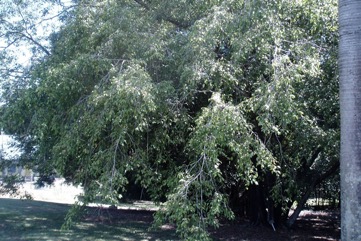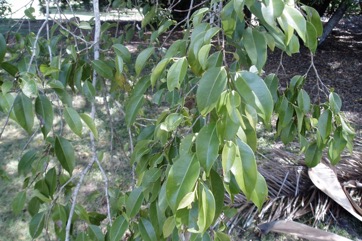Benjamin’s fig, Weeping fig

It is a tropical plant. It can grow in subtropical and warm temperate regions. It does best in rich, moist soil. It needs a protected sunny position. It is damaged by drought and frost. It can survive light frost. They need a minimum temperature above 15°C. It grows naturally in moist coastal monsoon vine forests. In China it grows in mixed forests between 500-600 m altitude in S China. It requires humidity and light. It grows below 700 m altitude in Vietnam. It grows on the edge of secondary forest. In XTBG Yunnan. It suits hardiness zones 10-12. Hobart Botanical Gardens.
Also known as:
Balete, Beringin, Charingin, Chilubor, Chhrey kreum, Chui ye rong, Co hay, Faiy kudhi nika, Jawi-jawi, Jejawi, Kabra, Kyet-kadut, Niakhusi, Nyaung-lun, Nyaung-thabye, Pakur, Pimpri, Pukar, Putra-juvi, Sai yol, Sai-yoi-bai-laem, Si, The Waringin, Waringin, Weringin
Synonyms
- Ficus comosa Roxb.
- Ficus lucida Aiton
- Ficus nitida Thunb.
- Ficus pyrifolia Salisb. [Illegitimate]
- Ficus retusa var. nitida (Thunb.) Miq.
- Urostigma nitidum Miq.
- and others
Edible Portion
- Fruit, Leaves
Where does Benjamin’s fig grow?
Found in: Africa, Asia, Australia, Bangladesh, Bhutan, Cambodia, China, Dominican Republic, East Africa, East Timor, Fiji, Haiti, Hawaii, Himalayas, India, Indochina, Indonesia, Laos, Malaysia, Maldives, Myanmar, Nepal, North America, Northeastern India, Pacific, Pakistan, Papua New Guinea, PNG, Philippines, Puerto Rico, Rotuma, SE Asia, Sikkim, Singapore, Solomon Islands, South America, Sri Lanka, Taiwan, Tasmania, Thailand, Timor-Leste, United States, Vietnam, West Indies, Zimbabwe
Notes: There are about 800-1000 Ficus species. They are mostly in the tropics. There are 120 Ficus species in tropical America.
Growing Benjamin’s fig, Weeping fig
Cultivation: Plants can be grown by cuttings, suckering or layering. Plants can be grown from seed,
Edible Uses: The fruit are eaten.
Production: It is moderately fast growing. In Australia plants fruit from August to October.
Nutrition Info
per 100g edible portion| Edible Part | Energy (kcal) | Protein (g) | Iron (mg) | Vitamin A (ug) | Vitamin c (mg) | Zinc (mg) | % Water |
|---|---|---|---|---|---|---|---|
| - | - | - | - | - | - |
Benjamin’s fig, Weeping fig Photos


References
Ambasta, S.P. (Ed.), 2000, The Useful Plants of India. CSIR India. p 221
Argent, G et al, nd, Manual of the Larger and More important non Dipterocarp Trees of Central Kalimantan Indonesia. Volume 2 Forest Research Institute, Samarinda, Indonesia. p 439
Barwick, M., 2004, Tropical and Subtropical Trees. A Worldwide Encyclopedic Guide. Thames and Hudson p 182
Bodkin, F., 1991, Encyclopedia Botanica. Cornstalk publishing, p 472
Brickell, C. (Ed.), 1999, The Royal Horticultural Society A-Z Encyclopedia of Garden Plants. Convent Garden Books. p 438
Brock, J., 1993, Native Plants of Northern Australia, Reed. p 186
Burkill, I.H., 1966, A Dictionary of the Economic Products of the Malay Peninsula. Ministry of Agriculture and Cooperatives, Kuala Lumpur, Malaysia. Vol 1 (A-H) p 1021
Cengel, D. J. & Dany, C., (Eds), 2016, Integrating Forest Biodiversity Resource Management and Sustainable Community Livelihood Development in the Preah Vihear Protected Forest. International Tropical Timber Organization p 120
Chase, P. & Singh, O. P., 2016, Bioresources of Nagaland: A Case of Wild 4 Edible Fruits in Khonoma Village Forest. in J. Purkayastha (ed.), Bioprospecting of Indigenous Bioresources of North-East India. p 50
Cooper W & Cooper W T, 1994, Fruits of the Rain Forest. RD Press p 128
Cooper, W. and Cooper, W., 2004, Fruits of the Australian Tropical Rainforest. Nokomis Editions, Victoria, Australia. p 322
Cundall, P., (ed.), 2004, Gardening Australia: flora: the gardener's bible. ABC Books. p 602
Dharani, N., 2002, Field Guide to common Trees & Shrubs of East Africa. Struik. p 107
Elliot, W.R., & Jones, D.L., 1992, Encyclopedia of Australian Plants suitable for cultivation. Vol 4. Lothian. p 281
Engel, D.H., & Phummai, S., 2000, A Field Guide to Tropical Plants of Asia. Timber Press. p 103
Etherington, K., & Imwold, D., (Eds), 2001, Botanica's Trees & Shrubs. The illustrated A-Z of over 8500 trees and shrubs. Random House, Australia. p 326
Flora of Australia, Volume 3, Hamamelidales to Casuarinales, Australian Government Publishing Service, Canberra (1989) p 37
Flora of Pakistan. www.eFloras.org
Forest Inventory and Planning Institute, 1996, Vietnam Forest Trees. Agriculture Publishing House p 553 (As Ficus retusa var. nitida)
French, B.R., 2010, Food Plants of Solomon Islands. A Compendium. Food Plants International Inc. p 75
Friday, J. B., 2005, Forestry and Agroforestry Trees of East Timor. http://www.ctahr.hawaii.edu/forestry/data/Timor/Timor trees.html
Greig, D., 1996, Flowering Natives for Home Gardens. Angus & Robertson. p 181
Hall, N. et al, 1972, The Use of Trees and Shrubs in the Dry Country of Australia, AGPS, Canberra. p 202
Hearne, D.A., & Rance, S.J., 1975, Trees for Darwin and Northern Australia. AGPS, Canberra p 69, Pl 19
Hibbert, M., 2002, The Aussie Plant Finder 2002, Florilegium. p 101
Hussey, B.M.J., Keighery, G.J., Cousens, R.D., Dodd, J., Lloyd, S.G., 1997, Western Weeds. A guide to the weeds of Western Australia. Plant Protection Society of Western Australia. p 182
Jackes, B.R., 2001, Plants of the Tropics. Rainforest to Heath. An Identification Guide. James Cook University. p 66
Jones, D.L. & Gray, B., 1977, Australian Climbing Plants. Reed. p 102
Jones D, L, 1986, Ornamental Rainforest Plants in Australia, Reed Books, p 218
Krishen P., 2006, Trees of Delhi, A Field Guide. DK Books. p 99
Lazarides, M. & Hince, B., 1993, Handbook of Economic Plants of Australia, CSIRO. p 114
Lord, E.E., & Willis, J.H., 1999, Shrubs and Trees for Australian gardens. Lothian. p 55
Martin, M.A., 1971, Introduction L'Ethnobotanique du Cambodge. Centre National de la Recherche Scientifique. Paris.
Molyneux, B. and Forrester, S., 1997, The Austraflora A-Z of Australian Plants. Reed. p 95
McMakin, P.D., 2000, Flowering Plants of Thailand. A Field Guide. White Lotus. p 55
Nakahara, K. et al, 2002, Antimutagenicity of Some Edible Thai Plants, and a Biocative Carbazole Alkaloid, Mahanine, Isolated from Micromelum minutum. Journal of Agricultural and Food Chemistry. 50: 4796-4892
Pasha, M. K. & Uddin, S. B., 2019, Minor Edible Fruits of Bangladesh. Bangladesh J. Plant Taxon. 26(2): 299–313
Peekel, P.G., 1984, (Translation E.E.Henty), Flora of the Bismarck Archipelago for Naturalists, Division of Botany, Lae, PNG. p 139, 143
Plants of Haiti Smithsonian Institute http://botany.si.edu/antilles/West Indies
Purseglove, J.W., 1968, Tropical Crops Dicotyledons, Longmans. p 389
Schuler, S., (Ed.), 1977, Simon & Schuster's Guide to Trees. Simon & Schuster. No. 113
Selvam, V., 2007, Trees and shrubs of the Maldives. RAP Publication No. 2007/12 p 92
Smith, A.C., 1981, Flora Vitiensis Nova, Lawaii, Kuai, Hawaii, Volume 2 p 175
Sujanapal, P., & Sankaran, K. V., 2016, Common Plants of Maldives. FAO & Kerala FRI, p 133
Sukarya, D. G., (Ed.) 2013, 3,500 Plant Species of the Botanic Gardens of Indonesia. LIPI p 281
Sundriyal, M., et al, 1998, Wild edibles and other useful plants from the Sikkim Himalaya, India. Oecologia Montana 7:43-54
Sundriyal, M., et al, 2004, Dietary Use of Wild Plant Resources in the Sikkim Himalaya, India. Economic Botany 58(4) pp 626-638
Sundriyal, M. & Sundriyal, R. C., 2004, Structure, Phenology, Fruit Yield, and Future Prospects of some Prominent Wild Edible Plant Species of the Sikkim Himalaya, India. Journal of Ethnobiology 24(1): 113-138
Swaminathan, M.S., and Kochnar, S.L., 2007, An Atlas of major Flowering Trees in India. Macmillan. p 263
Townsend, K., 1994, Across the Top. Gardening with Australian Plants in the tropics. Society for Growing Australian Plants, Townsville Branch Inc. p 211
World Checklist of Useful Plant Species 2020. Royal Botanic Gardens, Kew
Young, J., (Ed.), 2001, Botanica's Pocket Trees and Shrubs. Random House. p 383
www.eFloras.org Flora of China